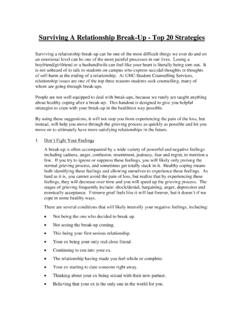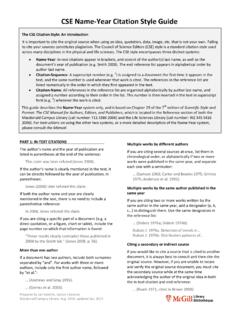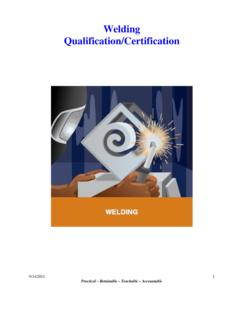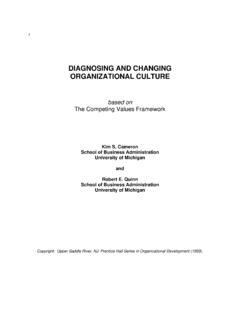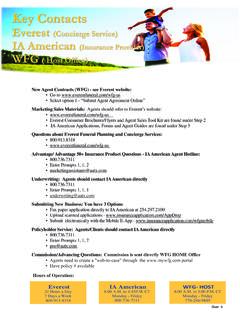Transcription of Panic Attack Helpful Hints - McGill University
1 Panic /ANXIETY ATTACKS A surprisingly large number ( , 35%) of college and University students have experienced a Panic /anxiety Attack . People who experience Panic attacks often describe them as the worst feeling they have ever had . People frequently experience their first Panic Attack in late adolescence and through their 20s. Panic attacks tend to increase in frequency, severity and duration, without some form of treatment. Approximately 3% of the population go on to develop Panic disorder, which includes recurring Panic attacks with fears of more attacks. The most commonly reported symptoms of Panic attacks include: Shortness of breath Intense fear, dread, or terror Tightening, discomfort, or pressure in the chest, neck, or back Racing or pounding heart Sweating Lump in the throat or choking sensations Dizziness or light-headedness Faintness Shaking or trembling Tingling in the hands or feet Dry mouth Nausea or butterflies in the stomach Hot flashes or chills Needing to urinate or defecate A strong desire to escape the situation De-realization ( , feeling unreal or dreamy) Depersonalization ( , feeling outside of yourself) Irrational thinking and irrational fears Remember, not everyone experiences the same symptoms or all of the symptoms listed.
2 These vary based on your own individual biological makeup. However, since these symptoms can be very intense, they are frequently misinterpreted and people often think they are dying, having a heart Attack , going crazy, suffocating, going to faint, losing control over their bodies, or going to embarrass themselves. Due to these fears, people often also come to fear that they will have another Panic Attack and frequently come to avoid either places or situations they believe may trigger another Panic Attack . Fortunately, these fears are unfounded and people can learn to both reduce and ultimately eliminate their Panic attacks. The following strategies will help you better understand and cope with your Panic attacks. 2 Coping Strategies 1.
3 Go For a Medical Consultation Before you do anything else, it is very important that you see a physician to rule out any potential medical reasons for your symptoms. In the vast majority of cases there are no medical concerns and knowing this in itself will produce a significant sense of relief. If there are specific medical issues that can explain your symptoms, address the medical conditions and your symptoms will likely resolve without further treatment. 2. Know That Panic Attacks Are Treatable Realize that Panic attacks are highly treatable if you are willing to educate yourself about the nature of Panic attacks and both learn and use the strategies listed in this handout. Statistics indicate that by using these strategies, 80 to 90% of people will experience relief.
4 Some people may need to enhance these techniques with medication if they have not responded to the strategies after a significant trial period. 3. Realize That Panic Attacks Can Do No Harm Understand that a Panic Attack cannot and will not cause you any harm or any of the following, even though you may fear it will happen. Panic attacks do not cause: Heart attacks Mental illness Respiratory failure Suffocation Fainting Loss of balance Loss of bodily control Strokes Death Panic Attack symptoms have never harmed anyone. Each of these fears are completely imaginary because you simply haven t understood what is happening to your body, the bodily changes feel so intense, and the symptoms have often occurred for no apparent reason.
5 Panic attacks can even wake you up out of your sleep. Understand that Panic attacks are a normal bodily response to perceived danger which occur even though there is no real danger in the situation. This response is commonly referred to as the stress response or the fight and flight response and has great survival value in that it prepares our body to either fight or flee a dangerous 3 situation. In a Panic Attack , the changes are physiologically indistinguishable from the stress response but serve no useful function since there is no real danger. Since the symptoms of a Panic Attack can be intense, they can also be very frightening. Realize that this response poses no danger to your body and could go on for hours or days without any adverse effect.
6 Each physical symptom you experience can be explained completely when we understand the purpose of the fight and flight response ( , to get your body ready to deal with a dangerous situation). 4. Don't Try To Stop All Symptoms Don t try to stop the Panic Attack immediately since this will prove unsuccessful and lead to more anxiety, fear, and frustration. Do begin to apply the strategies you are about to learn to calm your body and your mind. Once adrenalin is released into your body, it will take some time to metabolize so you can t stop the Panic Attack that second. Some symptoms will be experienced, but it will be short lived if you don t overreact to the symptoms. The symptoms will peak in 3 to 5 minutes and then quickly subside. 5.
7 Develop an Accepting Attitude Toward Your Symptoms Try to develop an understanding and accepting attitude toward your symptoms, knowing that there is no real danger. Allow yourself to simply accept what is happening in your body with the knowledge that you know how to manage it. Don t try to fight your symptoms. Just give them time to pass. 6. Use Positive Self-Statements Write out and, at the initial stages of the Panic Attack , begin to repeat some positive coping statements in your mind. You can use a single phrase or combination of statements, depending on what is successful for you. Use those statements that are most relevant to you and your symptoms. Some common positive coping statements include: "I know what is happening to my body.
8 I just need to begin my breathing." "I can accept the changes in my body because it poses no threat to me." "The worst that can happen is I ll feel uncomfortable. I can live with that." "I know what to do. I ve handled this effectively before." "This never lasts long if I use my strategies." "This is good practice to apply what I ve learned." "I can t stop the symptoms this second and I don t need to." "I can survive this. I ve done it before." "This is only anxiety. I m not going crazy." "I need to just go with the flow." 4 "This isn t a heart Attack . I ve had it checked out medically." "Nothing serious can happen to me. It s just unpleasant." "This is just the fight and flight response. There is nothing to fear.
9 " 7. Learn and Practice Diaphragmatic Breathing In conjunction with your positive coping statements, begin to do some diaphragmatic breathing. Since the fight and flight response is what we refer to as an all-or-none response, all you need to do is change one component of it to get control of the other symptoms. Since our breathing is under our conscious control, this is the first and often best place to start to induce the opposite response, , the relaxation response in our body. Diaphragmatic breathing involves slowly breathing in through your nose to the count of 4 or 5 and exhaling through your mouth again to the count of 4 or 5. If you re breathing properly, your stomach will rise at the end of each inhale. Put your hand on your stomach to assess whether you are breathing properly.
10 Also remember that learning to do diaphragmatic breathing is a skill and therefore, the more you practice it when you re not having a Panic Attack , the better you will be able to apply it when you need to. Diaphragmatic breathing will also prevent you from hyperventilating, which would only exacerbate a Panic Attack . 8. Use Distraction Techniques Engage in a wide variety of distraction techniques to alter the focus of attention away from the bodily symptoms you are experiencing. The range of potential distractions is truly limitless and can involve anything from simple repetitive activities to those that require very focused attention. Examples of some of these activities include: Counting backwards in threes from 100 Playing with the ring on your finger Watching the seconds ticking off on your watch Chewing gum Working on your computer Putting together a puzzle Talking to a friend Playing a musical instrument Focusing on your academic or work tasks 9.
